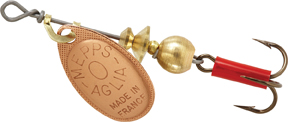Copper-the Reel Deal in Fishing Lures
Die-hard fishermen don't reveal the secrets of their success.
You won't hear them telling other fishermen about their favorite spots on the lake, or their special casting and retrieving techniques, or which baits work better for catching everything from striped bass to walleyes.
However, one not-so-well-known secret that has been handed down from generation to generation of anglers is that copper lures just seem to be better at attracting fish that are hiding or feeding in either fresh or salt water.
Jim Martinsen, a spokesperson for Mepps in Antigo, WI-one of the largest manufacturers of tackle equipment for the fishing industry, a brand sold in 58 countries worldwide-says the company makes stainless steel, brass and copper lures.
"We manufacture 4,000 different lures," says Martinsen, who has been with Mepps for 23 years. "Copper's been in the Aglia line for as long as I can remember. We don't sell a lot of them, but everyone seems to like them. At certain times, copper works where nothing else seems to."
According to Martinsen, copper lures are most productive after a heavy rainfall, when sediment has been stirred up and clouds the water. While all lures are designed to deceive fish into believing they are food, employing flashy, fish-like colors and emitting prey-like vibrations as they dart through the water, copper lures imitate certain baitfish better than others.
"When you drag a copper lure through a stream or lake, it takes on the color of a night crawler," Martinsen explains. "They work well under these conditions."
Copper lures vary in size, shape and weight, and are typically lacquered to prevent them from tarnishing. They range in price from $3 and $20 and are sold in most tackle shops and through various Web sites.
Because of its durability, longevity and recyclability, copper has long been the metal of choice for many different applications. The same qualities hold true for the fishing tackle industry.
The first "hooks" used to snag fish were probably made of wood or bone, but history notes that the ancient Egyptians fashioned fishing hooks from copper, the first metal used by mankind. The strong, malleable metal was an obvious choice as it could be worked into any shape and easily sharpened, and it greatly reduced the risk of breaking when a fish was hooked. This allowed people living along the Nile River to thrive because it enabled them to catch more fish with hooks that didn't quickly dull or wear out.
Even today, hooks are still often made of copper alloys, including bronze.
"A lot of companies use wire to make fishing lures, but ours are all hand-assembled and built to last generations," Martinsen says. "The durability of copper certainly plays a role in it."
Mark Kratz, fishing group sales manager for the Bass Pro Shops at Finger Lakes Mall in Auburn, NY, says copper wire is used for fishing lines and is favored among deep-water fishermen trolling nearby Lake Ontario and the other Great Lakes for salmon and steelhead trout. Copper wire is preferred over lead-core or steel wire line because it's heavier and has a smaller diameter than lead-core, allowing lures to run deeper with less line on the reel.
"Copper lines have been around for many years, but have really taken off in popularity over the last few," Kratz says. "They come in different weights and go real deep without having to use a downrigger. What's great is that they're quieter and don't give off a lot of vibration."
Copper lines are made from multiple strands of braided copper and are sold in spools ranging in price depending on the size and weight.
Martinsen prefers to use copper lures on cold, overcast days because it helps to have a big, bright reflective lure swimming through the dark water.
"We all really like the copper ones," he says. "There are definitely advantages to using them."
Bob Weed, a copper industry veteran, has fashioned his own lures over the years from the small copper and brass fittings and components he encounters in his work. Now vice president of automotive and OEM for the Copper Development Association (CDA), Weed says he first used copper lures as a boy with his father on fishing trips on the Great Lakes.
"My dad would take us fishing for bass, trout and salmon on lakes Huron, Erie and Michigan during the summer when we were off from school," he recalls. "He always preferred the copper lures because he said the fish were more attracted to the shiny metal reflecting in the water. They really worked well as a decoy, so we used them all the time."
While fishermen typically have tackle boxes filled with all types of gear - and sometimes even a few "secret" sure-fire, fish-catching lures - the smart angler always carries the ones proven to work best. Or, as Martinson recommends, "I would definitely make sure to keep a few copper ones in there." Cu

 Aglia Plain Treble Hook Spinner
Aglia Plain Treble Hook Spinner